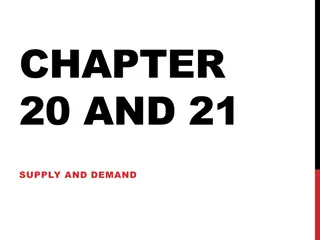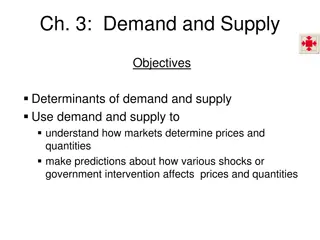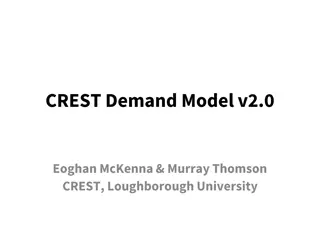
Household Demand for Public Services: The Median Voter Model
Explore the concept of household demand for public services through the lens of the median voter model and other approaches. Learn about the lack of a market price, how demand is revealed, and the household and community budget constraints involved in determining public service needs.
Download Presentation

Please find below an Image/Link to download the presentation.
The content on the website is provided AS IS for your information and personal use only. It may not be sold, licensed, or shared on other websites without obtaining consent from the author. If you encounter any issues during the download, it is possible that the publisher has removed the file from their server.
You are allowed to download the files provided on this website for personal or commercial use, subject to the condition that they are used lawfully. All files are the property of their respective owners.
The content on the website is provided AS IS for your information and personal use only. It may not be sold, licensed, or shared on other websites without obtaining consent from the author.
E N D
Presentation Transcript
Public Finance Seminar Spring 2019, Professor Yinger Demand for Public Services: The Median Voter and Other Approaches
Demand for Public Services Class Outline Household Demand for Public Services The Median Voter Model Estimating Household Demand
Demand for Public Services The Starting Point An household s demand for local public services, like its demand for private goods, depends on its income, the price of the services, the price of alternatives, and its preferences. But with 2 big twists: There is no market price. The demand for public services can be expressed in several different ways:
Demand for Public Services Lack of a Market Price Most public services are funded by taxes, not prices. Hence, the price is defined as the cost of an additional unit of service And this price depends on the tax system. Tax Price = How much would the individual pay if taxes were raised enough to provide one more unit of the service to everyone in the jurisdiction. A more formal definition will be derived later.
Demand for Public Services How Is Demand Revealed? The demand for services can be expressed: Through voting (today s class) Through bidding for housing and choice of a community (the subject of later classes) Through the purchase of private substitutes, such as private schools, security guards, or access to a gated community (not covered in any class, but worth studying!)
Demand for Public Services Household Demand for Public Services A Household s Budget Constraint Income (Y) must be spent on housing (H with price P), property taxes (tV=tPH/r) and other stuff (Z with price 1): = + + Y Z PH tV PH t = + + Z PH r t r = + + 1 Z PH
Demand for Public Services The Community Budget Constraint In a community, sending per household (E) to achieve the desired service level (S) must equal property tax revenue per household (t multiplied by average V ) and state aid, A. = + { } E S tV A Other local revenue sources are not considered here; state aid is considered in more detail in later classes.
Demand for Public Services Solving for Tax Price, 1 Solve the community budget constraint for t: { } E S A = t V Substitute into the household budget constraint: V A = + + ( { } E S ) Y Z PH V
Demand for Public Services Solving for Tax Price, 2 Tax price is the cost of one more unit of S, i.e., the derivative of the household budget constraint with respect to S, or, E V S V V = Tax Price = = TP MC V where MC is the resource cost of another unit of S, and the ratio of V to average V is the tax share. Note: If E is total spending, the tax share is V divided by total V a true share.
Demand for Public Services Estimating Household Demand With TP defined, we can write down a household demand function: = { , S Y TP , Other Prices, Preference Variables} S The problem: How to estimate this function? One answer: through surveys.
Demand for Public Services Survey Studies of Household Demand Approach 1: Surveys of voting on a referendum. The demand function defines a latent variable, which can be studied with a discrete-choice model, with Y and TP as explanatory variables. This approach also can be applied to a survey of preferences for increasing, decreasing, or not changing spending.
Demand for Public Services Survey Studies of Household Demand, 2 Approach 2: Surveys of spending preferences: How much would you like to spend? Use a multiplicative form with desired spending (= (S)(AC)) as the dependent variable (assuming AC=MC): V V = = S AY TP AY MC + V V = = 1 ( )( S AC ) E AY MC
Demand for Public Services The Median Voter Theorem Although household voting is not observed, the outcomes of voting in a community are easy to observe on referenda or in the form of spending or service levels. The median voter model provides a way to estimate a demand model at the community level where the data are!
Demand for Public Services Bergstrom and Goodman This famous paper (AER 1973) starts with an obvious point (the voter in the middle of the demand distribution is always on the winning side) It then adds assumptions about the structure of demand and taxes (that demand depends on Y and TP, that there is a property tax, and that the demand for housing, H, is a function of Y) And shows that the voting outcome in a community is determined by the voter with the median Y and median TP.
Demand for Public Services Bergstrom and Goodman, 2 In symbols: Median V V = = { , , } , , S S Y TP X S Y MC X Median Median Median This was revolutionary because it specified the demand for S using data just on median Y and median TP, which are readily observed. Scholars can proceed as if voting outcomes depend only on the demand of this abstract median voter.
Demand for Public Services Problems with Median Voter Models 1. Logical problems If demand is not one-dimensional and preferences do not take certain forms, the public choice mechanism may not be well defined. This is Arrow s Impossibility Theorem: it is impossible to write down a general model of public choice for complex decisions. Example: private schools. Some people with a high demand for public services under some circumstances (no private alternative) may have a low demand under others (a good private school nearby).
Demand for Public Services Problems with Median Voter Models, 2 2. Institutional problems The median voter model says institutions are neutral. Politicians and bureaucrats have no impact on observed spending or service quality (except perhaps through inefficiency more later). Also, results are assumed not to be skewed by non-participation. This may not be true. Example: renters. The tax price idea applies to owners, but its application to renters is unclear. Are public service benefits to renters cancelled by rent increases? It is also hard to find a significant renter variable in a median voter model.
Demand for Public Services Problems with Median Voter Models, 3 3. Tiebout bias More on this later. Basically, this is a form of selection bias in which people with low incomes but high demand for services based on unobserved factors end up in jurisdictions with high-quality services.
Demand for Public Services The Budget Constraints The Median Voter s Constraint t r = + + = + + 1 Y Z PH tV Z PH The Community Constraint (now with efficiency) { } C S e = + E tV A The Combined Constraint { } C S e V V V V + = + + Y A Z PH
Demand for Public Services Components Tax Price Spending S dC dS V V V V ( ) = = 1 1 TP e MC e Augmented Income V V + A Y Y A Because these terms come from the budget constraint, they appear in any demand function.
Demand for Public Services Components The augmented income term contains both voter income and state aid. The Bradford/Oates equivalence theorem (AER 1971) says these two components should have the same impact on voter demand for public services. But a large empirical literature (especially in education) says that intergovernmental aid has a much bigger impact on voter demand for the public service than does voter income. This is called the flypaper effect, labeled f, and we will consider it at length in the next class.
Demand for Public Services Tiebout Bias As discussed at length in later classes, household must compete for entry into desirable communities a literature that began with a famous article by Tiebout (JPE 1956). The people who win this competition are the ones with a higher demand for public services, which depends on their observed and unobserved demand traits. As pointed out by Goldstein and Pauley (JPubE 1981), these unobserved traits may create a correlation between the error term and the measure of service quality, and hence lead to biased estimates of income and price elasticities = Tiebout bias. Jurisdiction fixed effects, income distribution variables, and/or good data on jurisdiction traits are needed to minimize this bias.
Demand for Public Services Constant Elasticity Demand General Form V V V V ( ) = + + 1 (1 ) S K Y f A MC e Linear Form to Estimate V V V V ( ) = + + + + * 1 ln{ } ln (1 ) ln S K Y f A MC e A Y V V V V ( ) = + 1 (1 + + + * 1 ln ) ln K Y f MC e A Y V V V V Y ( ) = + + ln 1 (1 + + + * 1 ln ) ln K f MC e A Y V V V V Y e + + + + + * ln (1 ) ln ln ln K f MC 1 2 3
Demand for Public Services Constant Elasticity Demand, 2 Notes: 1. The last line uses the approximation that ln{1+ a} a. 2. This formulation differs slightly from Eom et al. (EF&P 2014), which has f alone instead of (1+ f) in the augmented income term. The version here has a flypaper effect of zero if the Bradford/Oates equivalence theorem holds; more on this in a later class.
Demand for Public Services The Big Problem: Endogeneity Note that this equation includes MC, which depends on the level of S, except in the unlikely event that there are constant returns to quality scale (i.e. the same cost for all units of S). It also includes e, which may depend on MC as well as on key explanatory variables, such as Y and tax share. A solution: Model MC and e. Most studies ignore these problems!
Demand for Public Services The Cost Function Enrollment A multiplicative form: C S = S W N P { } Teacher Salaries Student Traits implies that { } C S S = 1 MC S W N P
Demand for Public Services Efficiency Assume demand for services other than S and monitoring incentives depend on augmented income, TP, and other factors, M: V V V V ( ) = + + (1 ) e k M Y f A MC X Note that MC= MC{S} but e refers to other, unspecified outputs, so X is a cross-price elasticity.
Demand for Public Services The Full Expenditure Function Also recall that E = C{S}/e. Substitute MC and e into this expression to obtain ( )( ) 1 = ( 1) * X E k S W N P X V V V V + + (1 ) M Y f A which can be estimated in log form using the approximation discussed earlier.
Demand for Public Services The Demand Function Now substitute MC and e into the demand function and solve for S to get an estimating equation: * * V V V V ( )( ) e 1 = + + * * * (1 ) S K Y f A C where the expressions with asterisks can all be identified with the expenditure results; C* and e* only include determinants of C and e other than S. Note that the simultaneity problem is solved with algebra, not econometrics.
Demand for Public Services Common Error Most studies ignore e. But if e is a function of augmented income and TP, then the coefficients of these variables in a demand function reflect efficiency effects as well as demand effects. They do not just give demand elasticities!
Demand for Public Services Massachusetts (Nguyen-Hoang/Yinger) MA has property tax limits with overrides. MA has no independent school districts, so voter demand for education may depend on costs of other services. We observe 296 districts over 6 years We use year dummies, but no district fixed effects. Service quality is measured with a state-defined Student Performance Index.
Demand for Public Services Table 4. Demand Estimation Regression Results (2001-2006) Dependent Variable: Log of Student Performance Index Without logged non- school costs (??) ?? interacted with regional dummy (RD) Base (1) (2) (3) Income and price variables Chapter 70 aid component of adjusted income 1.576 1.871 1.917 (2.47)** (2.57)** (2.58)** Log of median income 0.082 0.076 0.075 (2.09)** (1.96)* (2.01)** -0.265 -0.288 -0.287 Log of tax share (-4.05)*** (-3.87)*** (-3.75)*** -0.472 -0.513 -0.504 Log of cost index (-6.38)*** (-6.33)*** (-6.08)*** 1.548 1.547 1.705 Log of efficiency index (4.01)*** (3.87)*** (3.67)*** Log of non-school costs -0.020 -0.034 (-1.82)* (-1.92)*
Demand for Public Services Other variables Regional districts (RD) (= 1 for RD and = 0 otherwise) -0.068 0.009 -0.079 (-1.98)** (1.02) (-2.03)** -0.249 ?? RD (-2.48)** 0.003 0.004 0.003 Percent of college graduates (3.63)*** (3.60)*** (3.75)*** 0.000 0.000 0.000 Percent of senior citizens (0.02) (0.07) (0.18) Percent of low-income students in comparison districts -0.001 -0.001 -0.001 (-2.33)** (-2.30)** (-2.13)** Percent of special ed students in comparison districts 0.008 0.007 0.007 (1.48) (1.37) (1.22) Year dummies (2002, 2003, 2004, 2005, 2006) Yes Yes Yes Constant Yes Yes Yes Number of observations 1776 1776 1776
Demand for Public Services California Estimates (D/Y 2011) About 900 school districts in two years (2003-04 and 2004-05) Service is measured by an index (API) of several tests in several grades developed for the California school accountability system. No fixed effects, but clustered errors.
Demand for Public Services Tax Price with Parcel Tax The budget constraints Parcel Tax Amount = + + Y Z tV P Number of Households { } C S e = + + E tV A NP Solve for P and substitute + { } C S eN tV A + = + + Y Z tV N Spending S 1 dC dS eN MC eN = = TP
Demand for Public Services Demand Results from California
Demand for Public Services California, 2
Demand for Public Services California, 3 These variables are instruments in the cost equation.
Demand for Public Services Three Challenges Units are not clear; performance is at student level, but voting is at household level; different studies use different adjustment methods (or none!). The role of renters is not clear; no study finds strong renter effect; perhaps renters don t care about the service level because better services mean higher rents. The role of Tiebout bias is not clear; income distribution variables do not seem to help, but jurisdiction fixed effects probably do.






















